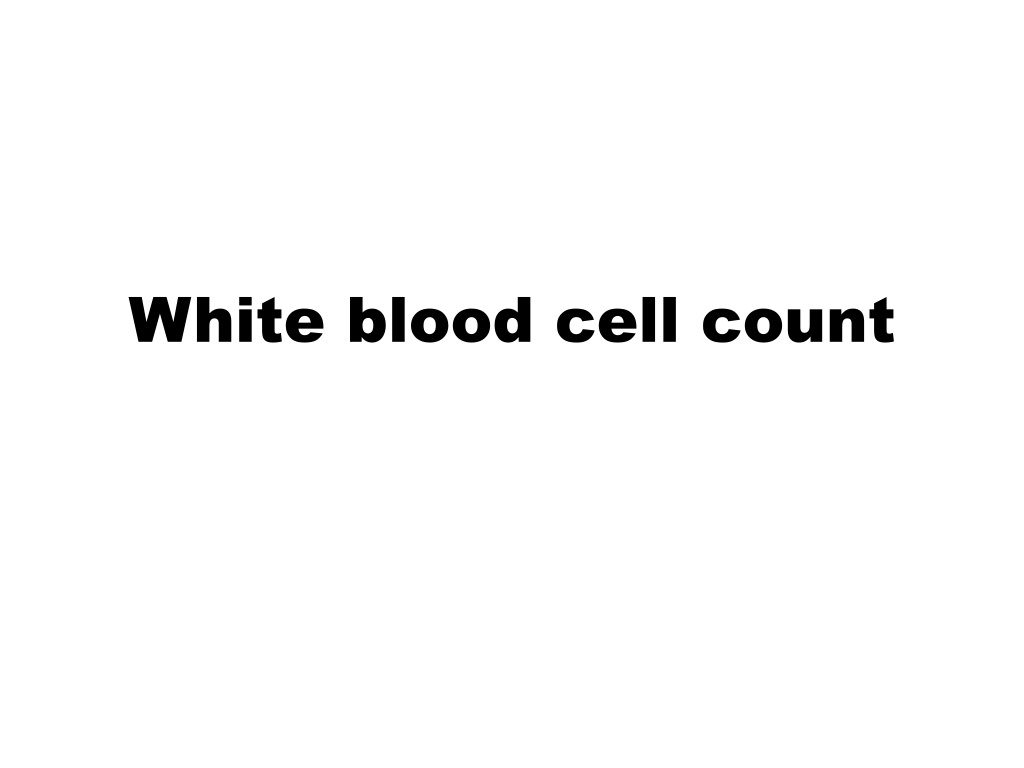Understanding White Blood Cell Count and Measurement Methods
White blood cell count measures the number of white blood cells in a specific volume of blood, indicating infection or disease progression. The normal range is 5000-11000 cells/cubic mm, varying with age. Methods include manual and electronic counting using specific instruments. Materials like anticoagulated whole blood and techniques such as diluting fluids are utilized. The procedure involves obtaining, diluting, mixing, and counting blood samples to determine WBC count accurately.
- White Blood Cell Count
- Measurement Methods
- Infection Indicators
- Disease Progression
- Laboratory Techniques
Download Presentation

Please find below an Image/Link to download the presentation.
The content on the website is provided AS IS for your information and personal use only. It may not be sold, licensed, or shared on other websites without obtaining consent from the author. Download presentation by click this link. If you encounter any issues during the download, it is possible that the publisher has removed the file from their server.
E N D
Presentation Transcript
Introduction The white blood cell count denotes the number of white blood cells per unit volume of whole blood. Normal WBC count range from 5000-11000 cell / cubic mm this count varies with age. WBC count is useful to indicate infection or may be employed to follow the progress of certain disease. WBC in the circulation are not white in the sense that a sheet of white paper is white, but in the sense that they are transparent and not colored. White cells are fewer in number than red cells.
Methods 1-Manual method 2-Electronic cell counting
Materials & instrument 1-Anticoagulated whole blood or capillary blood can be used. 2-Turk s diluting fluid composed of:- Glacial acetic acid (3ml) to hemolysed RBCs Aqueous gention violet (1% w/v) (1ml) to color the nuclei of WBC Distilled water up to 100 ml.
3- WBC pipette, which is composed of a stem, mixing chamber, white bead inside the mixing chamber, aspiration tube (rubber sucking tube) 4- Haemocytometer (Neubauer s counting chamber) with a cover slip. 5- Microscope 6- Lancet 7- Cotton
procedure Obtain a drop of blood in the same manner as in RBC count. Draw blood up to the mark 0.5 using WBC pipette. Aspirate diluting fluid up to mark 11. the dilution is 1:20. Remove blood from outside of the pipette with clean gauze. Gently rotate the pipette horizontally with your hand to ensure a proper amount of mixing for 3 minutes.
After mixing discard the first four drops of the mixture. Fill the counting chamber with diluted blood by holding the pipette at 45 with the slide and allow the mixture to seep under the cover slip, the filled chamber should be allowed to stand for a minute prior to counting. Count the WBC using the low power 10x objectives.
Count all WBCs in four large corner squares and add the result together to obtain the total number of cells counted. In counting the cells that touch the outside lines of the large square, count only those that touch the left and lower outside margin. The WBCs look like black dots.
calculation Count the number (N) of cells in 4 large squares located at the four corners of the chamber. The size 4 large squares in which N numbers of cells are found is: 1x1x1/10x4= 4/10 mm3 Where 1mm:- is the sideline of the large square 1/10 :- is the depth of the counting chamber between cover slip and the ruling 4:- is the number of large squares used to count
The total numbers of cells in 1mm3 are = Nx10/4 (before dilution of the sample) The actual total numbers of cells after dilution should be= Nx10/4x20=Nx50
Medical consideration Leucocytosis is the increased number of WBCs, this condition occurs in infection. Leucocytosis could also be physiological. People who have had their spleen removed (spleenctomy) will always have a slightly higher number of WBCs Eating, physical activity and stress can cause an increased WBC count. Pregnancy in the final month and labor may be associated with incraesed in WBC level.
Leucopenia is a condition of decreased number of WBCs . The WBC count tend to be lower in the morning and higher in the late afternoon. WBC count are age related. On average, normal newborns and infant have higher WBC counts than adults. It is not uncommon for the elderly to fail to develop leukocytosis as a response to infection. There are many drugs that cause both increased and decreased WBC count.
Leukemia is a group of malignant disorders of the haemopoietic tissue associated with an increase in the no. of primitive WBCs (blast cell) in the bone marrow and there will be a failure of cell maturation and the accumulation of useless cells which take up the bone marrow space and eventually this proliferation spills into the blood.























